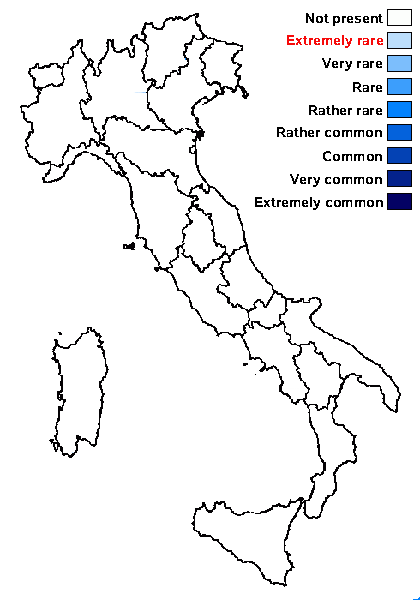Involucropyrenium romeanum (B. de Lesd.) Breuss
Herzogia, 29, 1: 197, 2016. Basionym: Verrucaria romeana B. de Lesd. - Bull. Soc. Bot. Fr., 58, 8: 662, 1912 (1911)
Synonyms: Involucropyrenium squamulosum (M. Brand & van den Boom) Breuss; Verrucaria squamulosa M. Brand & van den Boom
Distribution:
Description: Thallus small-squamulose, greenish grey to pale brown, matt, forming up to 4 cm wide patches. Squamules at first discrete, 0.1-0.3(-0.5) mm wide, c. 0.12 mm thick, rounded, flat to somewhat verrucose, slightly lobulate at margins, the older ones up to 1.3 mm wide and 0.3 mm tall, densely aggregated and often overlapping, incised with sometimes nearly isidia-like, 0.1-0.25 mm wide subunits. Epinecral layer lacking or up to 5(-10) µm thick; cortex 5-20 µm thick, paraplectenchymatous, pale brown in upper part, with roundish to angular, cells measuring 5-6 x 4-5 µm; medulla paraplectenchymatous, with subglobose, c. 5 µm wide cells which are less compact than in cortex, the parts below perithecia with up to 15 urn wide clusters of crystals. Hypothallus rarely well-developed to 0.3 mm thick, sometimes with 7-10 µm wide oil-cells. Rhizohyphae rare, colourless, 2-4 µm thick. Perithecia black (often whitish to brown near the ostiole), subglobose, mostly immersed, numerous. Involucrellum black, well developed, 50-70 µm thick, reaching the base of the perithecia but open at the base, contiguous with the exciple or slightly spreading in lower part: exciple with a relatively short neck, 1.2- 2.6 µm thick, prosoplectenchymatous, pale brown below in older perithecia; periphyses simple to sometimes branched, strongly coherent, septate, 25-50 x 1-3 µm, interascal filaments absent. Asci 8-spored, clavate, with biseriately arranged spores, the wall I-. Ascospores 1-celled, hyaline, ellipsoid to ovoid, (23-)24-27(-28) x (8-)9-13(-15) µm. Pycnidia black, inconspicuous, c. 0.1 mm across. Conidia short-bacilliform with rounded ends, sometimes slightly curved, 3.8-4.4 x 0.9-1.1 µm. Photobiont chlorococcoid. Spot tests: cortex and medulla K-, C-, KC-, P- UV-. Chemistry: without lichen substances.Note: on calcareous rocks, including man-made substrata; rather common in Western Europe, with a few records from the Alps outside Italy, but perhaps overlooked or misidentified elsewhere; to be looked for in Italy
Growth form: Squamulose
Substrata: rocks
Photobiont: green algae other than Trentepohlia
Reproductive strategy: mainly sexual

Predictive model
Growth form: Squamulose
Substrata: rocks
Photobiont: green algae other than Trentepohlia
Reproductive strategy: mainly sexual

Predictive model
 Index Fungorum
Index Fungorum
 GBIF
GBIF


